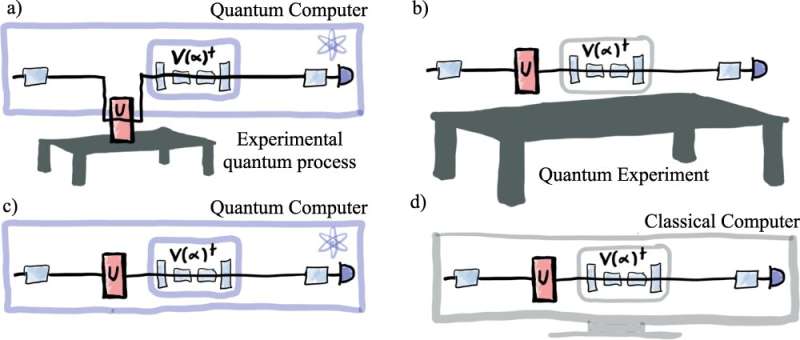This article has been reviewed according to Science X's editorial process and policies. Editors have highlighted the following attributes while ensuring the content's credibility:
fact-checked
peer-reviewed publication
trusted source
proofread
Simple data gets the most out of quantum machine learning

New theoretical research proves that machine learning on quantum computers requires far simpler data than previously believed. The finding paves a path to maximizing the usability of today's noisy, intermediate-scale quantum computers for simulating quantum systems and other tasks better than classical digital computers, while also offering promise for optimizing quantum sensors.
"We show that surprisingly simple data in a small amount is sufficient to train a quantum neural network," said Lukasz Cincio, a quantum theorist at Los Alamos National Laboratory. He is a co-author of the paper containing the proof published in the journal Nature Communications. "This work takes another step in the direction of making quantum machine learning easier, more accessible and more near-term."
The new paper emerged from a collaboration between a Los Alamos team, lead author Matthias Caro, of Freie Universität Berlin, and other researchers from the United States, United Kingdom and Switzerland. The group has been developing the theoretical basis for more efficient algorithms, particularly for quantum machine learning, to exploit the capabilities of these noisy machines while the industry works on improving the quality and enlarging the size of quantum computers.
The new research paper builds on previous work by Los Alamos National Laboratory and its collaborators demonstrating that training a quantum neural network requires only a small amount of data. Taken together, these recent theoretical breakthroughs prove that organizing training with very few and very simple states offers a specific approach to performing practical work on today's limited quantum computers faster than on conventional, classical-physics-based computers.
"While prior work considered the amount of training data in quantum machine learning, here we focus on the type of training data," Caro said. "We prove that few training data points suffice even if we restrict ourselves to a simple type of data."
"In practical terms, it means you can train a neural network on not only just a few pictures of cats, for example, but also on very simple pictures," Cincio said. "For quantum simulations, it means you can train on quantumly simple states."
"Those states are easy to prepare, which makes the entire learning algorithm much easier to run on near-term quantum computers," said co-author Zoe Holmes, professor of physics at École Polytechnique Fédérale de Lausanne and former Los Alamos postdoc.
A near-term application for quantum computers
Noise in the form of interactions between quantum bits, or qubits, and the surrounding environment causes errors that limit the processing capabilities of current quantum computer technology. Despite the noise, quantum computers excel at certain tasks, such as simulating a quantum system in materials science and classification of quantum states with machine learning.
"If you are classifying quantum data, then there's a certain amount of noise you can tolerate and still get the answer right," Cincio said. "That's why quantum machine learning may be a good near-term application."
Quantum machine learning tolerates more noise than other kinds of algorithms because tasks such as classification, a staple of machine learning, don't require 100% accuracy to deliver a useful result, said Andrew T. Sornborger, a co-author of the paper. Sornborger is the leader of the Quantum Algorithms and Simulation thrust area of the Quantum Science Center. Led by Oak Ridge National Laboratory, the center is a collaboration among national laboratories, including Los Alamos, universities and industry.
The new paper shows that using simpler data allows a less-complex quantum circuit to prepare a given quantum state on the computer, such as a quantum-chemistry simulation showing the evolution of a system of molecules. A simple circuit is easy to implement, less noisy and thus able to complete a computation. The new Nature Communications paper demonstrates a method for compiling quantum machine-learning algorithms using simple-to-prepare states.
Off-loading to classical computers
Complex quantum algorithms exceed the processing ability of even very large classical computers. However, the team also found that because their new approach simplifies developing algorithms, compiling quantum algorithms can be off-loaded to a classical computer. Then the compiled algorithm can be run successfully on a quantum computer. This new approach allows programmers to reserve quantum-computing resources for the tasks they can uniquely perform but that choke classical computers, such as simulating quantum systems, while avoiding the error-causing noise of long circuits on quantum computers.
The Lab's research has applications in the developing field of quantum sensing. Exploiting certain principles of quantum mechanics enables the creation of exquisitely sensitive devices for measuring gravitational fields or magnetic fields, for example.
"Quantum sensing methods in the absence of noise are straightforward and well understood theoretically, but the situation becomes much more involved when noise is considered," Sornborger said. "Adding quantum machine learning to a quantum-sensing protocol enables you to apply the method when the encoding mechanism is unknown or when hardware noise affects the quantum probe." That application of quantum machine learning is under investigation in a Department of Energy-sponsored project led by Lukasz Cincio and Marco Cerezo, also of Los Alamos.
More information: Matthias C. Caro et al, Out-of-distribution generalization for learning quantum dynamics, Nature Communications (2023). DOI: 10.1038/s41467-023-39381-w

















